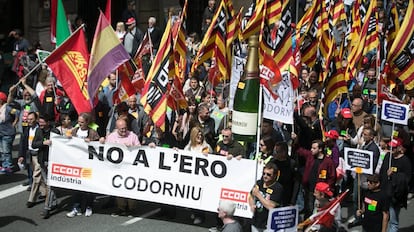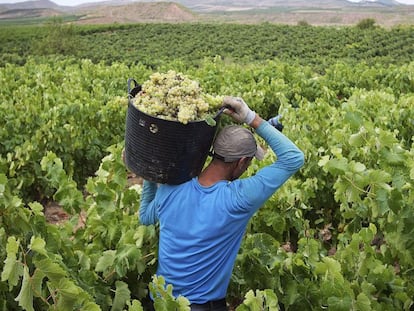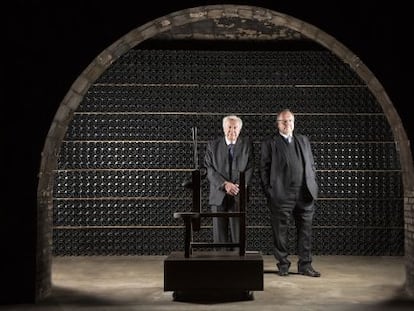The Spanish cava hangover
Stagnation of sales in Spain and strategy to drop ‘own brand’ products proving bad for business

More than 10 years ago, a tense debate over Catalonia’s status within Spain sparked a boycott of cava from the region in the rest of the country – a protest from which the sector has never recovered. But early this year, the region’s sparkling wine industry appeared to bounce back, bubbling with optimism as it gave the future a positive spin.

Presenting sales results for 2016, the chairman of the Cava Regulatory Council, Pere Bonet, downplayed the importance of the drop in domestic sales of around 700,000 bottles (0.8%) and predicted better results based on general economic recovery in Spain.
A “necessary” price hike has hurt sales of Spanish bubbly in foreign markets
However, two weeks ago, the cava giant Codorníu announced that it would stop production for third parties, with 93 workers to be made redundant. Freixenet, meanwhile, is beset by infighting among its main shareholders, suggesting an altogether flatter outlook.
“The sector is starting to crack,” warns Miguel Ángel Domínguez, who heads up the food industry division for the CCOO general workers union in Catalonia.
In the last 10 years, there has been a drop of 12% in the consumption of cava in Spain and, despite Bonet’s confidence, there is no sign of a reverse in the trend. During the crisis, the sector was propped up by exports, which accounted for 65% of the market. And while consumption abroad continues to rise – particularly in non-EU countries such as Russia – domestic sales remain stagnant.

Both the government and the sector believe that some of the fault lies with the undervaluation of the product, resulting in a price hike last year, which Bonet deemed a “necessary” move – though not one that went down well in countries such as Germany, where sales have dropped by 14%, and Belgium and Britain, where Italian prosecco is proving popular.
According to Bonet, “A marketing push on premium champagne is vital for consolidation.” This strategy has been adopted by both Freixenet and Codorníu, who are boosting profit margins by investing in luxury labels that now account for 12% of sales.
House brand
On the downside, this strategy has meant the end of house brand production and redundancies in Codorníu. The oldest family firm in Spain makes cava for huge supermarket chains in Britain such as Tesco’s but while production of this brand represents a fifth of the group’s production, it accounts for only 5% of revenue, according to union sources.
The cava sector is starting to crack Miguel Ángel Domínguez, union spokesperson
Freixenet cut down on production for third parties four years ago. However, the company, which belongs to the Bonet, Ferrer and Hevia families, had net profits of just €2.35 million in 2016, an improvement of 6.7% on the previous year, but hardly impressive for such a prestigious brand. And while shareholders have expressed their disappointment, the three families are struggling to reach a consensus on how to keep them happy.
English version by Heather Galloway.
Tu suscripción se está usando en otro dispositivo
¿Quieres añadir otro usuario a tu suscripción?
Si continúas leyendo en este dispositivo, no se podrá leer en el otro.
FlechaTu suscripción se está usando en otro dispositivo y solo puedes acceder a EL PAÍS desde un dispositivo a la vez.
Si quieres compartir tu cuenta, cambia tu suscripción a la modalidad Premium, así podrás añadir otro usuario. Cada uno accederá con su propia cuenta de email, lo que os permitirá personalizar vuestra experiencia en EL PAÍS.
¿Tienes una suscripción de empresa? Accede aquí para contratar más cuentas.
En el caso de no saber quién está usando tu cuenta, te recomendamos cambiar tu contraseña aquí.
Si decides continuar compartiendo tu cuenta, este mensaje se mostrará en tu dispositivo y en el de la otra persona que está usando tu cuenta de forma indefinida, afectando a tu experiencia de lectura. Puedes consultar aquí los términos y condiciones de la suscripción digital.
More information
Archived In
Últimas noticias
Maduro pleads not guilty before the federal court in New York: ‘I am still the president of Venezuela’
A new test can detect Alzheimer’s from a finger prick
UN team enters Sudanese city of El Fasher after paramilitary massacre: ‘It’s like a ghost town’
A recipe for resistance: Indigenous peoples politicize their struggles from the kitchen
Most viewed
- Gilles Lipovetsky: ‘If you want to live better and fall in love, take Prozac, don’t look to philosophy’
- Alain Aspect, Nobel laureate in physics: ‘Einstein was so smart that he would have had to recognize quantum entanglement’
- Maduro’s downfall puts China’s relationship with Venezuela to the test
- Why oil has been at the center of Venezuela-US conflicts for decades
- Alvin Hellerstein, a 92-year-old judge appointed by Bill Clinton, to preside over Maduro’s trial in New York










































